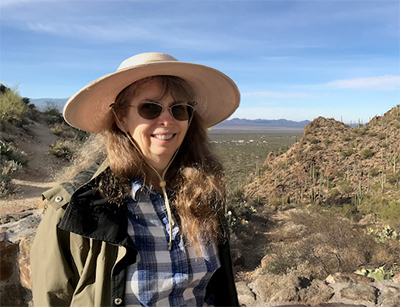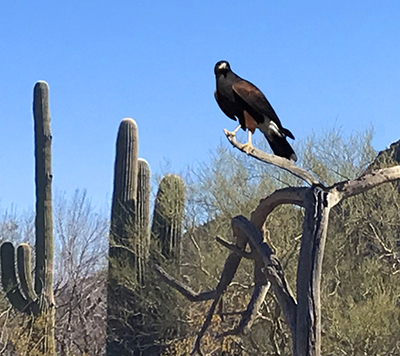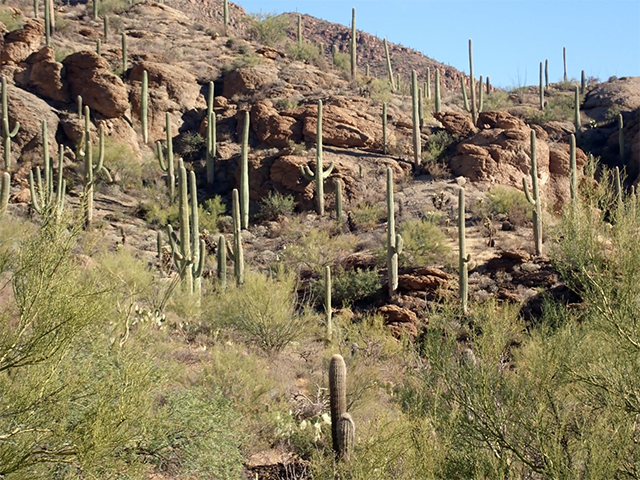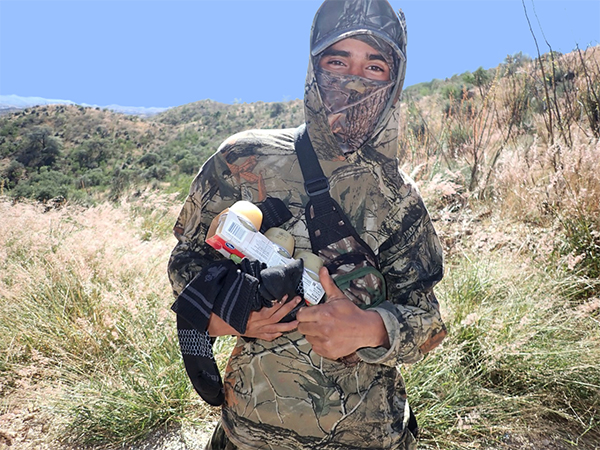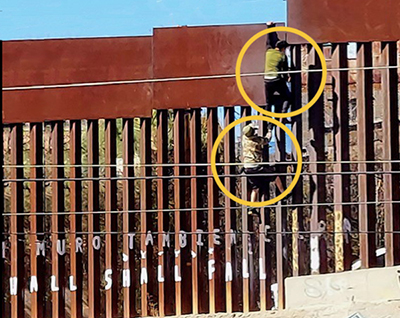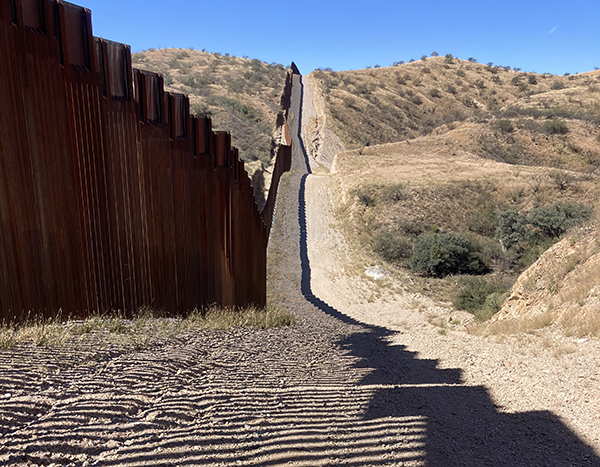P e a c e a n d U n d e r s t a n d i n g |
Feature Story
|
|
We had the privilege of seeing the US/Mexico border wall from the comfort of an SUV, free to cross into Mexico and back as we wished, when we wished. We had planned a trip to Arizona for a contra dance event and decided to spend an extra five days in the Tucson area to visit the border with human rights volunteers, and to stay with Servas hosts including one of our organization’s most active volunteers, Carol Trible (who is also a contra dancer!).
Carol Trible - US Servas member & Tucson Samaritan It was a special experience to be in the stunning beauty of southern Arizona in mild fall weather; we learned a lot about the amazing desert ecosystem.The Arizona-Sonora Desert Museum illustrates the diversity of the Sonoran Desert, which spans five states in the U.S. and Mexico.It offers exhibits on dessert wildlife and plants.We learned about growing agave for tequila while standing in the most beautiful succulent planting we’d ever seen. The javelinas were sleeping, but at least we can say we saw the pig-like creatures that eat Carol’s herb garden at night!
Harris hawk looking for food - Raptor Demonstration The outstanding live raptor demonstration was the most naturalistic bird show we’d ever experienced — and it was an experience to have these majestic birds literally graze the tops of our heads in pursuit of food offered by their handlers. The road from Tucson to the Desert Museum leads through Tucson Mountain Park, which made us stop and gape: the statuesque saguaro cacti stand in dense assemblies, arms pointing to the sky as if making a statement. Each has its own character: all stand strong among the rocks and up the steepest ridges. They defy time and the elements while offering nesting space to birds and flowers to pollinators. Growing between the saguaros is a collection of smaller cacti, trees including palo verde, mesquite and creosote, along with sages and other shrubs so harmonious and lush that it is hard to think of them as spiny plants in a dry, harsh environment. In the morning, the moisture-laden blades of prickly pear cacti glisten in the sun, far into the horizon.
Saguaro Cacti Forest The Sabino Canyon Recreation Area is just east of Tucson. On a hike with naturalists, we gained many insights into desert ecology. We learned about the important collaboration between trees and cacti through their root systems. We touched the plant that Pima Cotton was developed from. We didn’t only botanize: the birding was outstanding. Two hours from Tucson, we toured Chiricahua National Monument where we took picture after picture – there was an ever-better view around the next corner! And a great gift shop at the visitor center, which loans out hiking poles to those in need. Along with joy and discovery, the desert also gave us an acutely sobering lesson: the migrants who cross the border have a wholly different experience. Unprepared, they find that every plant boasts prickly defense mechanisms, venomous rattlesnakes are common, water is scarce or contaminated, nights are freezing and days scorching. But saving lives is a passion that runs hot along the Arizona-Mexican border, and our Servas host Carol Trible is part of a network of volunteers trying to help in any way they can. (See details and other resources below.) With Gail Kocourek of Tucson Samaritans, Carol took us on a day-long drive on rough, rollercoaster roads with our eyes scanning the small trees, shrubs and cacti looking for migrants in distress.
| In the Tucson area, five organizations are active in supplying migrants with water, food, blankets, first aid supplies and clothing - especially socks. “A blister can cost you your life out here,” said Gail. The volunteers also make phone calls to families to give them urgently awaited updates. People from all over Mexico and South America assemble in small towns along the border waiting for their group to cross into the U.S. Some pay to get picked up by a vehicle on the other side — if they can find the spot with the map they’re given. Others are taken to the border and left to their own devices. “See that glow? That’s Los Angeles — just a short walk” is a lie that some are told. Before they started their treacherous journey, they paid a steep price, often selling everything they owned or borrowing money to make the trip, with the hope of finding economic opportunity or escaping gang violence or dangerous prejudice. Over the past ten years, more than 4,000 people have died while crossing the Arizona desert; wooden crosses are placed in the spots where their remains were found as reminders of that sad fact, but many bodies are never found. Gail skillfully drove the SUV along a 10-mile section of the border, the roughest stretch of the trip. The vehicle is clearly marked with the logo of the Tucson Samaritans. Stopping at openings that still exist in the 30-foot steel bollard wall, she yelled into the steep hills that we were there to help. “Somos amigos!” If nobody came to meet us, we left gallon jugs of water. In several spots we encountered "hawks", or lookouts: young men who live in makeshift camps and help the coyotes shepherd the migrants to crossing points.
Hawk shows gratitude for supplies They are the lowest-ranking employees of cartels, and they appear to be as unprepared for the conditions as the migrants – one came out of the bushes shivering. Gail asked them how many were in their group, and we handed them supplies for their camp. “Coyotes” run the human smuggling operations for the cartels, and the treatment of their ‘clients’ is said to be often abysmally cruel. A migrant who is slower than the group is usually abandoned, left to find his or her way alone in the desert. Gail and Carol told us many stories from their years doing this work: “Once, a group of migrants heard our car coming and thought we were the border patrol. They climbed over that wall in three minutes.” Gail has found migrants in such dire condition that she thought they were dead. The volunteers provide basic medical care but, beyond that, their hands are tied: the law does not allow anyone except the Border Patrol and emergency vehicles to transport undocumented immigrants.
Multi-billion $$ Wall - No Match for the Determined The volunteers give the migrants the best advice they can: “If they’re in bad shape we must inform them of the dangers that lie ahead and how many people have died trying this walk. We suggest that they give themselves up to the Border Patrol, in which case they will probably get deported. Some decide to continue, trying to outsmart the Border Patrol which searches for them in SUVs, all-terrain vehicles, and with drones and cameras on towers. Many give up. Many break down and cry.Citizens of some countries are subject to easier immigration conditions than others because of Title 42, that restricts entry due to COVID measures.People who believe they have cause to be granted asylum (“credible fear”) tend to wait along a road to be found. Unaccompanied children go to detention camps and have a chance of being united with family in the U.S. after an anxious wait time. The volunteers and the border patrol generally get along fine. “They know me by now — I’m the crazy lady with white hair”, said Gail. “The officers often thank us.”But there are more players in this field: In fall the volunteers wear bright clothes so the hunters can recognize them and not shoot. And there are several private militia groups acting as vigilantes, including one affiliated with Q-Anon. They have occasionally harassed the volunteers, and it is thought that they vandalize water stations, threaten migrants and even harm some. At the end of our search, we visited the Casa de la Esperanza, a migrant center in Sasabe, on the Mexican side of the official border crossing. This small town has no post office, bus service or bank, yet many migrants are brought here before crossing in the hills a few miles away. A small center provides them with food and drinks, showers, clothes, and information – all free of charge. Across the street, a library will soon be built. For us, the most memorable aspect was the warm smiles of the women who bring out plates of hot food in this clean and welcoming space. Beyond the humanitarian issues, there are numerous problems with border walls, both environmental and economic. It’s difficult to know exactly how much taxpayer money has been spent on the wall but a common guesstimate is $18 billion. And it has become |
clear that the wall is neither effective nor practical for controlling immigration.
“When laborers were allowed to cross the border seasonally,” said Gail, “they would work in the fields to harvest a crop of strawberries, cherries or tomatoes, and between crops they were able to go home to their families.” Many have a tax ID number and pay taxes but can never use any benefits. Tighter border policies have forced migrants into harsher and more remote territory. If they succeed in entering the United States and finding work, they need to stay put, always in fear of being discovered, without a safety net and scared to report crimes or abuse they experience. Wage theft is common. Environmental impacts are complex and inter-connected. The possibilities for severe environmental degradation are well explained in 6 Ways the Border Wall Could Disrupt the Environment from National Geographic and “The Environmental Consequences of a Wall on the U.S.-Mexico Border” from NPR. Here is a brief summary. The US-Mexico border stretches for 1,954 miles over one of the nation’s most diverse landscapes. It includes six separate eco-regions. Proposals for certain stretches of wall would divide land along the Rio Grande Riveras well as various wildlife conservation areas, refuges, and a state park, placing some of the land on the Mexican side.Border walls increase soil erosion, alter natural water flow and the patterns of wildfire. They disconnect wildlife from their range south of the border, isolating animal populations and limiting their ability to roam for food, water, mates, and birthing sites, as well as to escape fires, floods, and heat waves. This, in turn, affects plants. The seeds of mesquite trees, for example, germinate best after they have passed through the digestive systems of javelinas and coyotes. Flooding disasters occur when walls clog with debris, or the road built along the wall stops water from flowing through its natural channels during thunderstorms. This has already caused millions of dollars in property damage in places like Nogales on the Mexican side and at Organ Pipe Cactus National Monument. Construction of the border wall is exempt from more than 30 of the most sweeping and effective federal environmental laws, such as the Endangered Species Act, National Environmental Policy Act, the Clean Air Act, and the Clean Water Act. That’s due to the REAL ID Act, passed by Congress in 2005; it authorizes Homeland Security to waive any laws in the name of national security.
Endless miles of expensive, ineffective, eco-harming fence It’s easy to look away from all these complicated issues. But each individual who risks his or her life by braving this trip does so to escape very difficult conditions or to save their families. Our day at the border had us thinking: what would we do if our children or parents were hungry or threatened by violence? Leaving behind one’s family and community for a country where one is not welcome must be a very hard choice to make. United States history and geography are intimately connected with that of our Latino neighbors to the south.Our economy is strongly aided by their many contributions, and our culture is enriched by theirs. Real, balanced immigration reform would benefit everybody, including the thousands of businesses and homes that benefit from hard-working immigrant laborers. I (Andrea) speak from experience: as a landscape designer, I need a variety of garden plants for my clients. Since late 2017, there has been a shortage of labor in the nursery industry, and we’re often unable to obtain the plants we order.Most nursery jobs require hard, repetitive labor usually performed outdoors; these jobs are predominantly done by Latino workers. Unfortunately, our policy makers are not anywhere close to fixing a broken immigration system. In the meantime, I hope you will get to know some of your Latino neighbors and ask them to tell you their stories. More to Ponder Salvavision& Casa De La Esperanza in Sasabe,Mexico Book The Devil’s Highway by Luis Alberto Urrea, Book Crossing with the Virgin: Stories from the Migrant Trail Book A Stranger at My Door: Finding My Humanity on the U.S./Mexico Borderby Peg Bowden If you buy these beautiful,comfortable, and solid quality products, one item for every item you purchase will be donated to homeless shelters, migrants, and others in need. We personally handed out some of their socks at the border. Podcast Death by Policy by Latino USA National Geographic article 6 ways the border wall could disrupt the environment. |

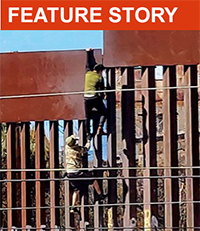 Andrea Veltman and David Schwartz
Andrea Veltman and David Schwartz 